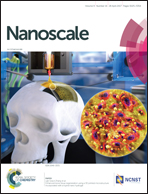Enhanced bone tissue regeneration using a 3D printed microstructure incorporated with a hybrid nano hydrogel
Abstract
Three-dimensional (3D) functional constructs with biomimetic mechanical and chemical properties are ideal for various regenerative medicine applications. These properties of 3D fabricated constructs mainly depend on the intrinsic characteristics of the materials and fabrication method. In this respect, the current use of hydrogels for musculoskeletal tissue repair is not ideal due to the lack of suitable mechanical properties, as well as the high biomimetic requirement for success. To overcome this limitation, we developed a novel functionalized hydrogel with bioactive gold nanoparticles (GNPs), reinforcing a 3D printed microstructure via fused deposition modeling (FDM) for bone tissue regeneration. We used biodegradable thermoplastic polylactic acid (PLA) as the 3D printed microstructure in combination with photo-curable gelatin hydrogels as the encapsulation matrix for the incorporation of cyclic RGD conjugated GNPs (RGNP), and investigated their mechanical properties. In addition, human adipose-derived stem cells (ADSCs) were encapsulated within the gelatin hydrogel and examined for viability, morphology, and osteogenic differentiation in vitro. The results showed that the stiffness of the composite hydrogel on reinforcing a 3D printed microstructure can be readily modulated to simulate the stiffness of the human mandibular condyle. ADSCs encapsulated in the composite structures remained viable within the hydrogel and showed excellent spreading on the 3D printed PLA microstructure. More importantly, osteogenic differentiation with incorporated RGNPs promoted significantly higher gene expression of osteogenic specific factors. Therefore, reinforced composite hydrogels are suitable for stem cell differentiation control and bone tissue regeneration.



 Please wait while we load your content...
Please wait while we load your content...